WHYTROPHY
ロゼット/ワイトロフィー
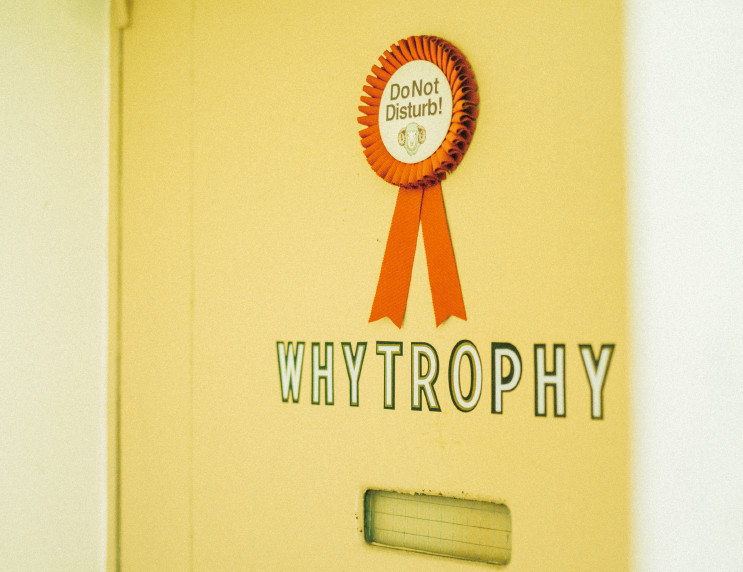
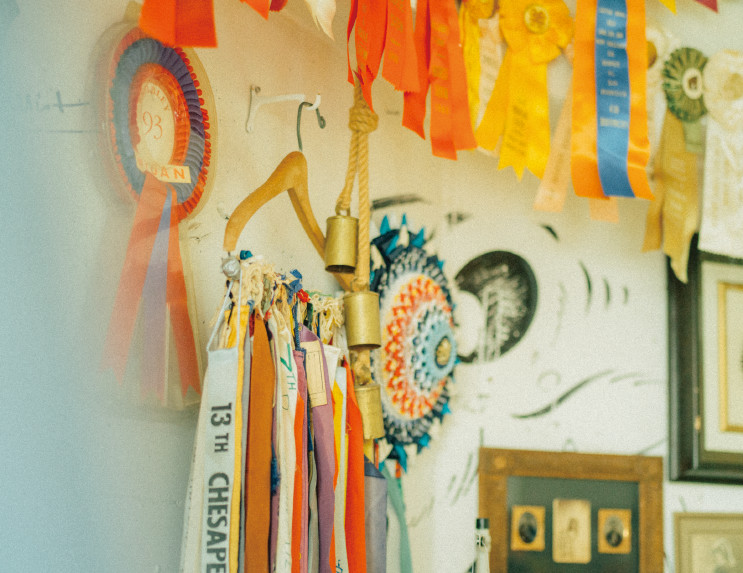

“称えること”をかたちに。世界にひとつのロゼット
「WHYTROPHY(ワイトロフィー)」。その不思議な響きに出会ったのは、数年前に事務所の設立記念日にと、友人がまっ白いトロフィーをプレゼントしてくれた時だった。そのトロフィーの中央に付けられていた落ち着きのある淡い緑色のリボンで作られた徽章が、格調高い雰囲気なのにパッと垢抜けていて印象に残った。トロフィーなんて小学校のときにサッカー大会で優勝してチームでもらった以来のことだったから、なんだかちょっと照れくさかったけれど、事務所に置いたその白いトロフィーを見ると誇らしい気持ちになって、いつも心がほころんだ。そのトロフィーに付けられたロゼットと呼ばれるリボンを素材にした徽章を作っているのは、高澤敬介さんと瑞穂さんご夫婦だ。ファッションブランドやJRA、スヌーピーミュージアム、そして雑誌MilK JAPONなどとの協業や、子供たちとのロゼット作りワークショップなど、活躍の場を広げているWHYTROPHYのおふたり。“称えること”に着目し、その奥深い世界へとあくなき探求を続けるおふたりにお会いしたくて、世田谷は深沢にあるアトリエを訪ねた。 「Why Trophy?」
WHYTROPHY: I was introduced to this the name through my friend who gave me the gift of a white trophy commemorating the founding of my own company. There was an elegant pale-green rosette at the center of that trophy that made an impression on me. The last time I could remember receiving a trophy was after my team won a soccer tournament in elementary school, so I was somewhat embarrassed, but now every time I look at the trophy in my office it brings me joy and makes me feel proud.
The hands behind the making of this rosette belong to a married couple, Keisuke and Mizuho Takazawa. Under the name WHYTROPHY, they have collaborated with fashion brands, JRA, the Snoopy Museum, and magazine MilK JAPON, while organizing workshops that teach children how to make rosettes. We wanted to meet the duo that continues to focus ever deeper on the world of rosettes while valuing the idea of ‘praise’ as the primary purpose of their work, so we visited their studio in Setagaya, Tokyo. Let's ask the question, “Why Trophy?”
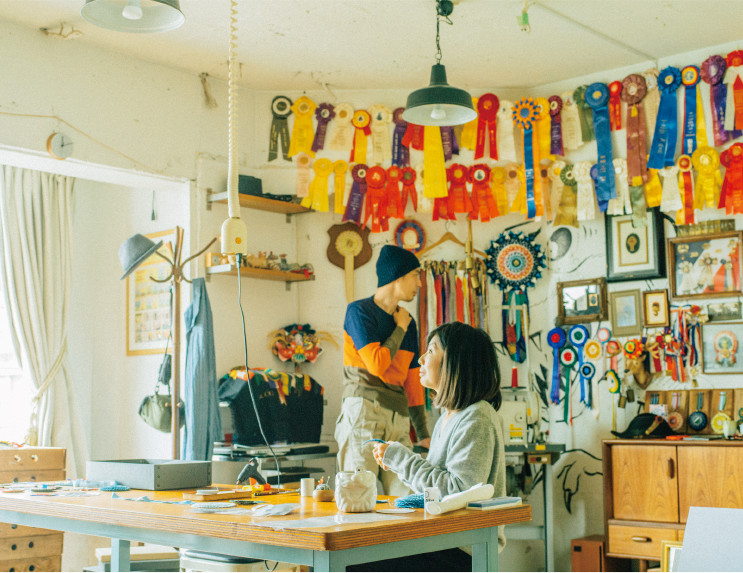
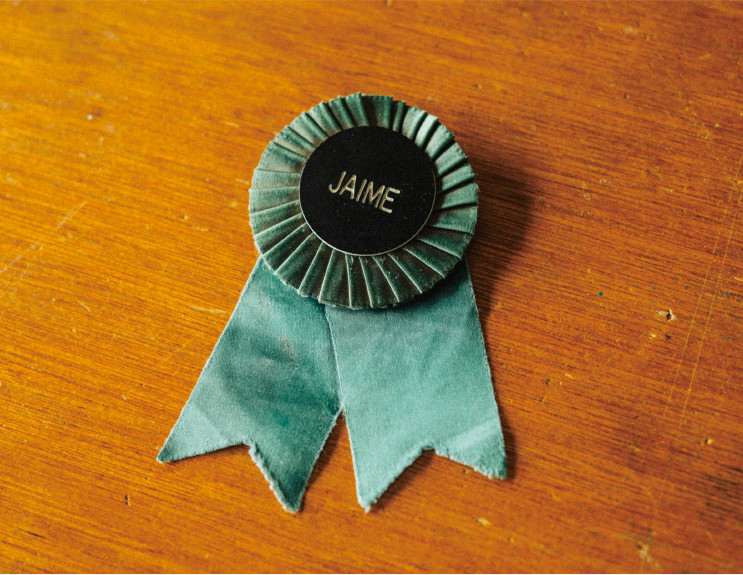
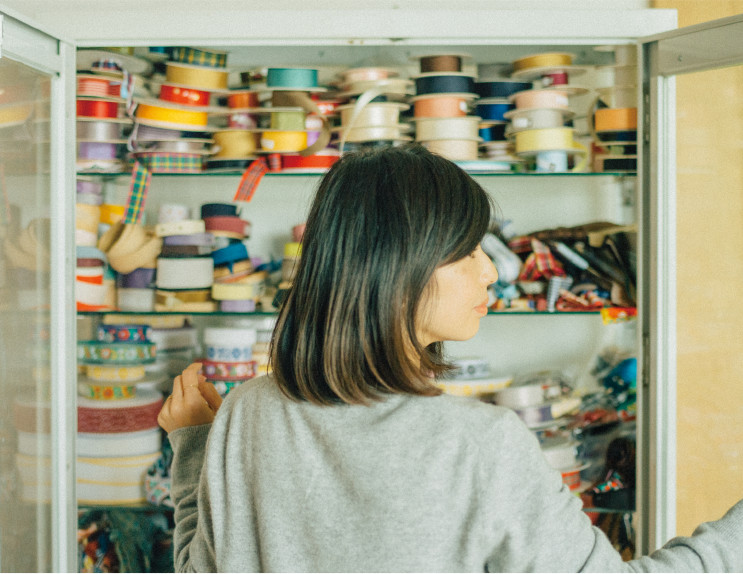
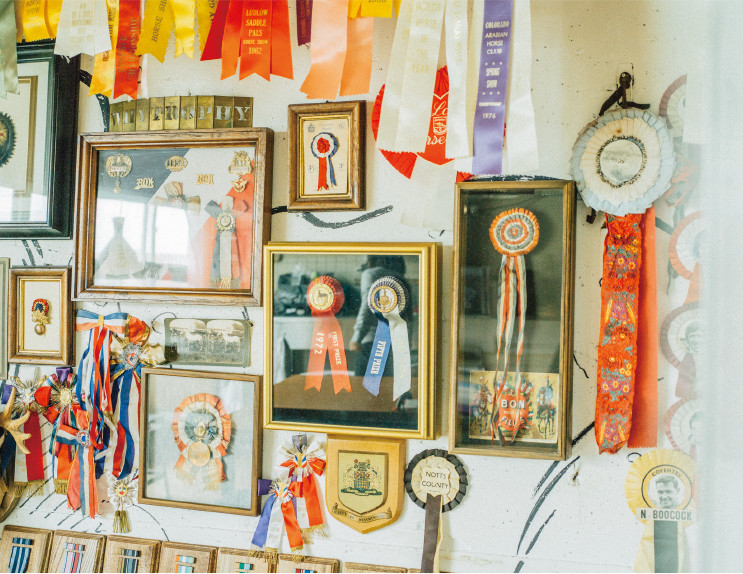
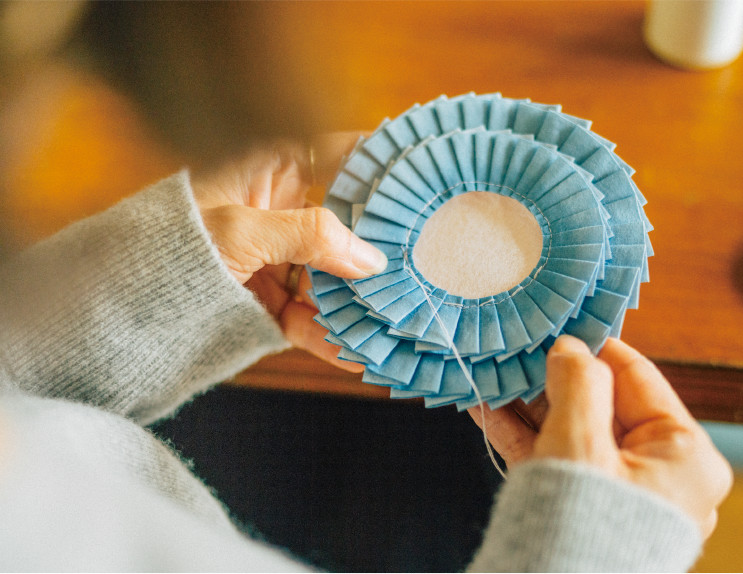
駒沢公園から歩いて10分ほどの距離にある、東京オリンピックの年に建てられたという味わい深いマンションの一室。ここが高澤敬介さんと、瑞穂さんご夫婦がアトリエとして1日を過ごす空間だ。壁には、ふたりが世界各地で見つけてきた、さまざまな種類のロゼットが所狭しと掛けられている。ロゼットというのは、大会で賞をとった時にもらえるバッジのような徽章のことで、丸く形づくられたプリーツとボタンなどのセンター部分、そこから下がるテールと呼ばれるリボンでできている。近づいてひとつひとつよく見てみると、印刷した写真が中央に貼ってあるだけのチープなものや、何世代もの時代を超えてきたような、とてもお金では買えなそうなもの、おばあちゃんがカウチに座って縫ったような手作り感いっぱいのもの。ひとくちにロゼットといってもこんなに形も色も素材も違うものがあることに驚いた。部屋の窓際には、あの白いトロフィーも。 WHYTROPHYとして、ロゼットをつくりはじめた当時、雑誌の編集に関わるライターだった敬介さん、結婚と妊娠を機に仕事を離れていた瑞穂さんが、なぜ“誰かを称えること”に興味を持ち、ロゼットと向き合うようになったのか。ふつふつと湧いてくる興味を紐解くように、おふたりにお話をうかがった。
A 10-minute walk from Komazawa Park, we started our exploration in a quirky apartment built in the year of the Tokyo Olympics, 1964. This is the space that Keisuke and Mizuho spend their day. The walls are covered with rosettes small and large from their travels abroad. Rosettes are badge-like emblems that are typically given to someone when they win an award. They have a circular center part often times made of pleat and a button with a tail made of ribbon. Stepping up to get a closer look at them, we could see that some were cheaply made with a printed photo at the center, while some seemed to have lasted centuries, and others seemed to be knitted by grandma while she sat on her favorite knitting couch. We were surprised at the variety in shapes, colors and materials. By the window silently sat the same white trophy given as a gift.
So how did Keisuke, who was a writer and editor for a magazine, and Mizuho, who was taking maternal leave when they started making rosettes for WHYTROPHY, become interested in ‘praising others’ as the theme of their work? We sat down with the pair of them, their story unraveling as these questions floated to the surface.
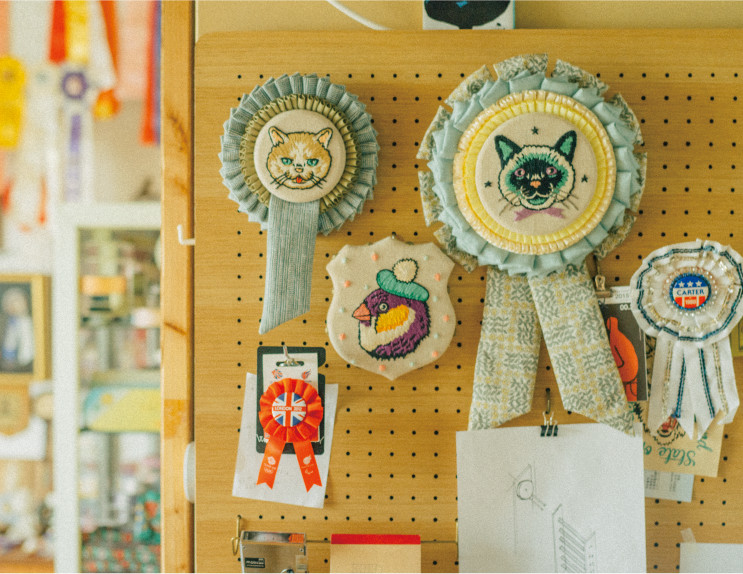
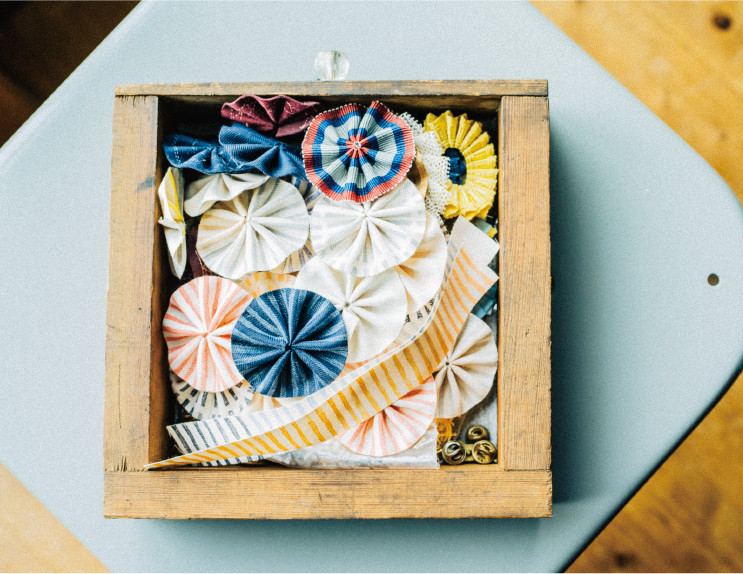
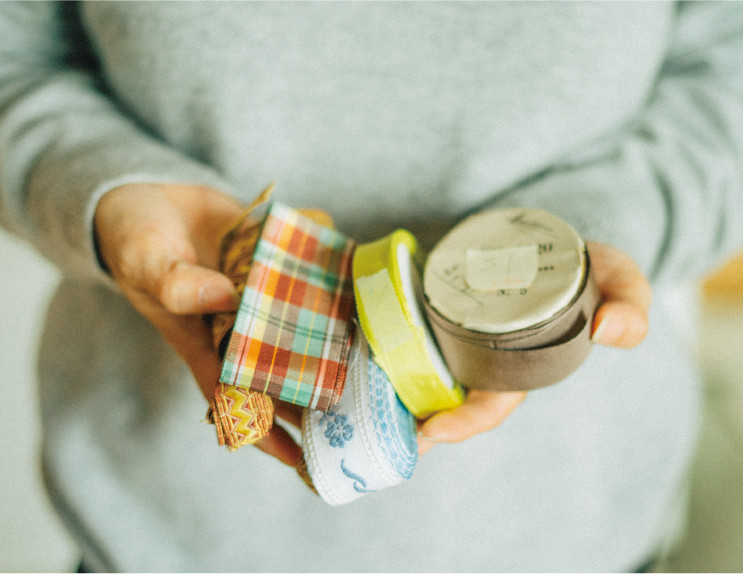
ーまずはWHYTROPHYとしての活動をはじめた経緯を教えてください。
敬介さん) 僕はライターとしてファッションやカルチャー誌の原稿を書いたり、映像制作会社でCMや映画の制作をしていました。そのころから友達の誕生日など特別な日にトロフィーを贈っていたんです。それからトロフィーに付けるリボンを模索するうちにロゼットと出会い、妻とWHYTROPHYの活動をスタートさせました。
瑞穂さん) 私は大阪で服飾とアクセサリーを学んだあと、東京で販売の仕事をしていました。主人と出会い、結婚、妊娠を経て仕事を辞めたころ、彼のトロフィーに付けるために初めてロゼットを作りました。
– Tell me what led to your starting WHYTROPHY
Keisuke: I was working as a writer for a culture and fashion magazine while also working in production making films and commercials for a production company. At the time I used to give friends trophies as a gift on their birthdays or for big celebrations. Then as I started exploring options for ribbons to add to trophies, I discovered rosettes, and my wife and I started our efforts as WHYTROPHY.
Mizuho: After I studied fashion and accessory making in Osaka, I worked a retail job in Tokyo. I met my husband, we got married and I quit my job during my pregnancy. It was around then that I made a rosette for the first time – for one of his trophies.
ーそもそもどうして誕生日プレゼントにトロフィーを?
スタイリストやカメラマンとか、お仕事をしている方に何かを贈りたいと思うとき、何でも知ってる彼らに喜ばれるものって何だろう?といつも困ってたんです。あるときスポーツ用品店で売られていたバスケットボールのトロフィーが目に留まって。バスケが好きな人だったから、あげたらすごく喜んでもらえた。そうやって、友達の誕生日が来るたびにトロフィーを贈るようになりました。もともとトロフィーには「勝利・戦利品」という意味があったり、デコラティブなデザインに自分も影響を受けた80年代のポストモダン的なものを感じたりして、そんな側面にも惹かれていました。
– Why give trophies as a birthday present?
I wanted to give gifts to friends of mine who were stylists or cameramen, people who work really hard and seem to have knowledge on a wide variety of subjects, so it was always hard to come up with good ideas. One day, I saw a basketball trophy at a sporting goods store. The friend I was shopping for loved basketball, so I gave it to him and he was so delighted. It started there, and soon I realized I was gifting trophies every time there was a friend's birthday. Trophies imply victory and celebration, and their decorative design align with my postmodern influences from the 80's, too, so that made them appealing.
ー最初は普通のトロフィーだったんですね。
そう。だけど買ったトロフィーを贈るだけでは物足りなくなってきて、リサイクルショップを回ってたくさん買い集めて、それを組み合わせるということをやってみたんです。でもパーツの種類が限られていて、これはあんまりおもしろくないなと。それから成形工場を探して、使えそうなものを組み替えて白く塗りました。トロフィーの持つ意味や記号を一旦ニュートラルな状態にしたくて。
– So you started with normal trophies?
That's right. But I soon became unsatisfied with simply gifting trophies that I found, so I went to thrift stores and started buying them up where I could. I'd take pieces from different trophies and combine them into one. But the parts lacked variety and I soon lost interest in that as well. So I looked for useful shapes at molding plants, combined them and painted them white. I wanted to take the inherent meaning of trophies and bring it back to a neutral state.
ーなるほど。では、ロゼットとの出会いは?
この白いトロフィーに付けるリボンをずっと探してたんですけど、街の徽章店にはいわゆるバラ飾りしかなくて。そんなときに海外の徽章店で売っていたリボンの飾りを見つけて、これだ!と思いました。それから日本では見つけることのできなかったさまざまな種類のロゼットやそれに類するものが海外にはたくさんあることを知りました。だけどイギリスやアメリカにあるメーカーに問い合わせてみたものの、僕らのような小商いは取り合ってもらえませんでした。いてもたってもいられなくなった僕らは、とにかく見よう見まねで作ってみることにしたんです。
– I see. How did you discover rosettes?
I looked for ribbons to put on these white trophies for a long time, but shops in town only had those that went with rosy decorations. Then we found a ribbon at an emblem shop overseas that made us say, “This is it!” We soon learned that there are all shapes and sizes in the family of rosettes that you don't see in Japan. We reached out to merchants in England and America, but small businesses like ours were unable to do business with them. We finally started making them ourselves by hand.
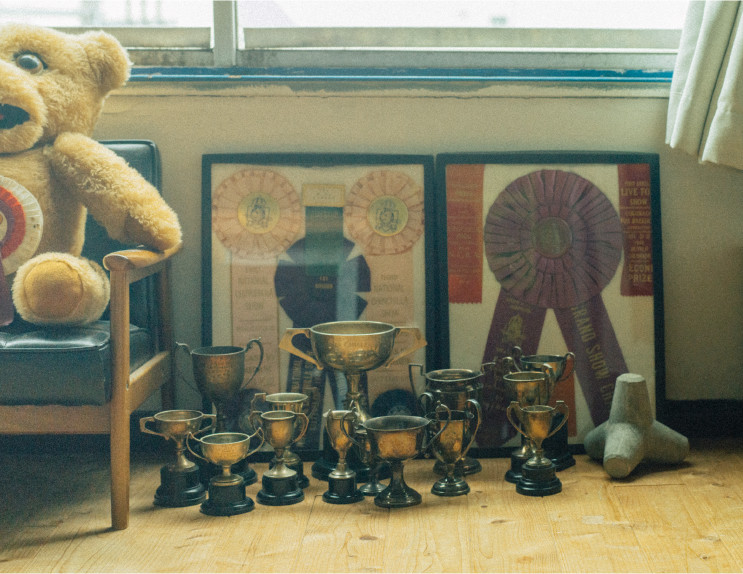
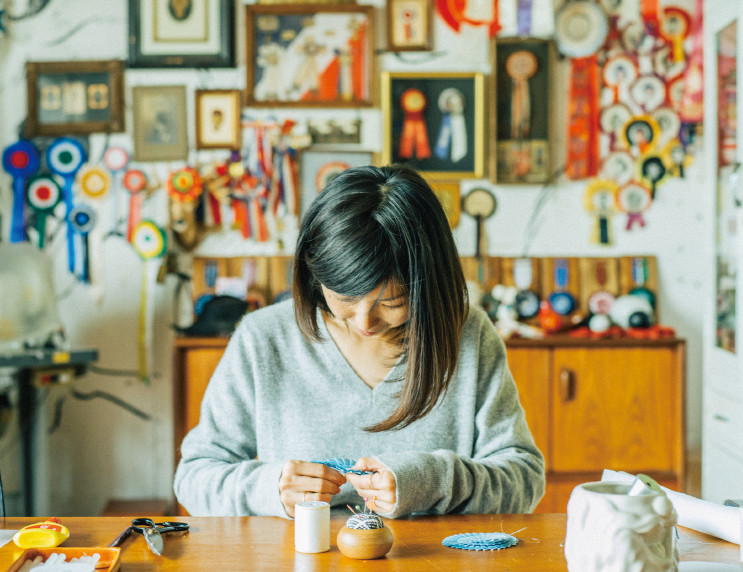

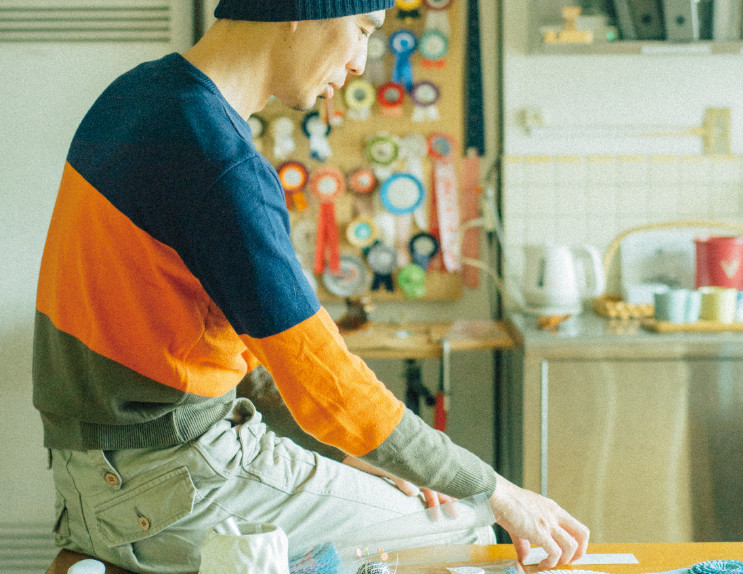
ーすごい。 出来栄えはどうでしたか?
リボンを買ってきて瑞穂が縫ってみたら意外と上手にできてしまって(笑)。それをスタイリストの友達に見せたらかわいいねって言ってもらえたのも嬉しかった。それからしばらく作ったロゼットやトロフィーを友達の展示会なんかで出品したりしていたんですが、オリジナルの商品として出展してみようと動き出した時に、やっぱりこのままでは売れないと踏み留まっちゃったんです。
– Impressive. How did they turn out?
Actually, we bought some ribbon and Mizuho sewed one together more easily than we expected (laughing). We showed it to a stylist friend and she thought it was cute, which was encouraging, too. For a while we displayed our rosettes in our friends' exhibitions and things, but in 2010 when we started preparations for our own exhibition, everything came to a grinding halt. We didn't feel like we could sell our rosettes just as they were.
ーそれはどうしてですか。
これはライターとしての性分かもしれませんが、トロフィーやロゼットを扱うのであれば、誰よりも詳しく知っておかないとオリジナルを作ることはできないと思ったんです。デザインや様式を模倣するのではなくて、生まれた背景を知ることが必要だなと。それを解釈したあとに何が作れるのか。そこに僕たちなりの想いを込めることができればと思ったんです。日本語で「ロゼット」と検索しても全く情報はないし、海外にも書籍や図録もなかった。これはもう本場の本物を見に行くしかないと思いました。
– And why is that?
This might be part of the nature of being writer, but I thought we had to know the ins and outs of trophies and rosettes better than anyone else to make something original. We needed to know the history of how these objects came about, not just copying the design or technique that was once used to make them in the past. What would our rosettes look like then? I thought that could be the key to imbuing our emotion into our work. There's no information online if you search “rosette” in Japanese and we didn't find books or records of rosettes overseas, either. We felt our only remaining option was to go see the real thing for ourselves, no matter where that might be.
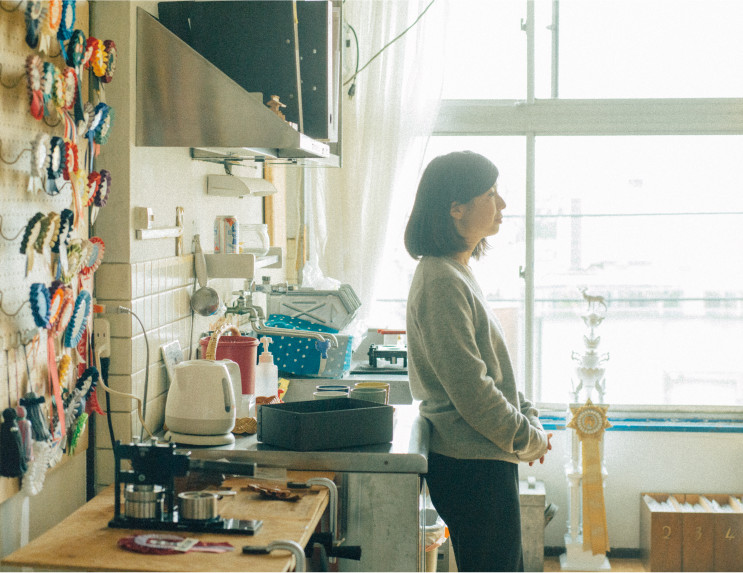
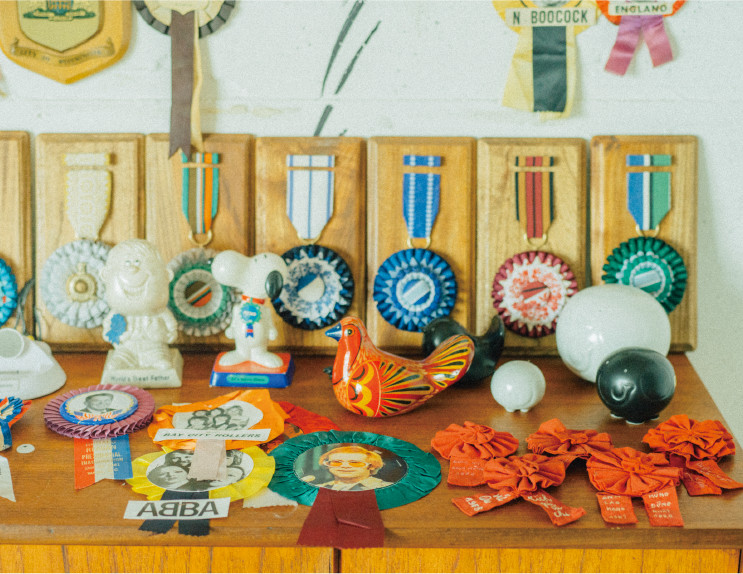
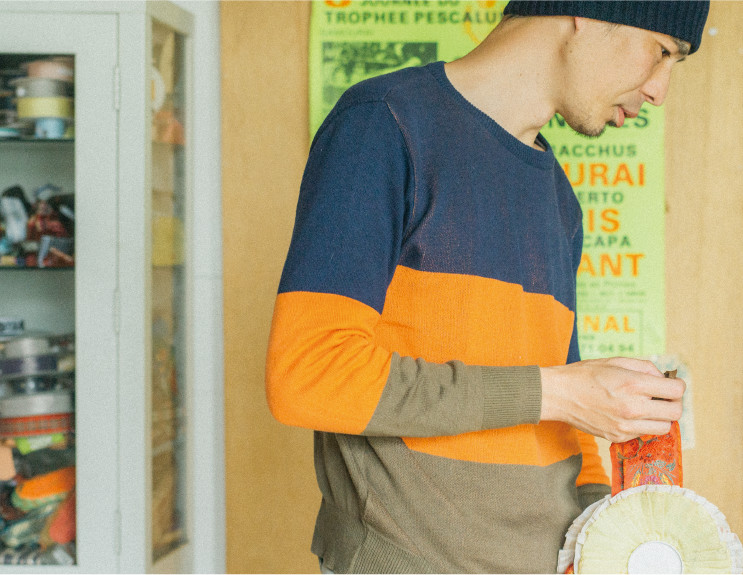
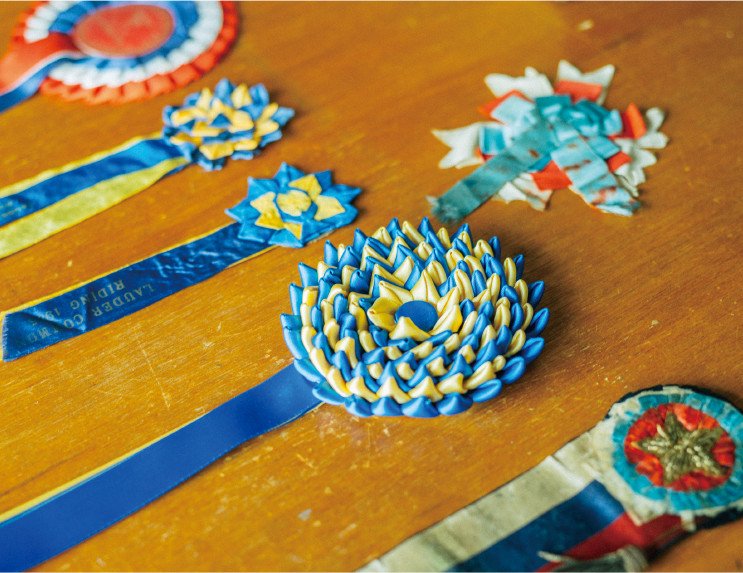
ーなるほど。そこから世界各地のロゼットを探す旅※が始まったんですね。 ※著書 ロゼット〜リボンの勲章をさがして〜
この本の取材で、高澤さんたちはロゼットにまつわる情報を聞きつけては、実際に現地に足を運んでいます。イギリス郊外で行われる家畜の品評会や、英国王室ファンを訪ねたり、スコットランドの馬の早駆け、チェコのモラヴィア地方の祭り、南フランスの闘牛、アメリカのドッグショー、そしてインドの地方選挙まで! 各地でロゼットがどのように使われているのか見聞を広げていくにとどまらず、ロゼットの由来や、時代や世相に合わせ形を変えてきたロゼットの在り方にまで想いを馳せています。この旅によって、WHYTROPHYの考え方に影響を与えたことがあれば教えてください。
海外にロゼットの取材に行くたびに、誰かが大切にしているロゼットに出会います。例えば、死んでしまった愛犬や愛馬がコンテストでもらったロゼットを大切に残している方に話を聞いたり、博物館の倉庫に保管されている喪章だったり。そういった経験をしていくうちに、残るものを作りたいと思うようになりました。そうしたロゼットと並べられてもおかしくないものを作っていければと。
僕たちは僕たちの言葉で語り、作り続けていくことがやるべきことだと思っています。自分たちがどういうものを作っているのかをちゃんと知って向き合うこと、そして伝えていくことが大切だと感じています。かつては敵味方を見分ける帽章だったり、愛国心の象徴になったり、戴冠などのめでたい席に使われたり、ファッションのアイコンになったりと「ロゼット」には色々な記号があるけれど、僕たちWHYTROPHYもロゼットの長い歴史を踏まえた文脈の上に立っていたい。だから作り続けられているものがあるならば由来や作り方を教えてもらい、途絶えてしまったものが残っているならば、できるだけ近くで見てみたい。そうやって全てを知ったうえで、これまでなかったものを作ることができれば、それが僕らのオリジナリティになるのではと考えています。
– I see. So that's how your journey around the world searching for rosettes began. *The Takazawa's are authors of the book, Rosette ~The Great Search for Ribbon Medals~. They traveled far and wide when they heard any new information about rosettes. On their travels they saw a livestock fair in an English suburb, they visited fans of the English royal family, horse races in Scotland, a fair in Moravia, Czech Republic, bull fighting in southern France, dog shows in America, even local elections in India! Not only did they deepen their understanding of the various uses of rosettes, they learned where they came from and how they changed form as history progressed.
– How did this journey influence the way WHYTROPHY thinks about rosettes?
Every time we travel overseas for research, we discover a rosette cherished by someone. For example, we've spoken to people who hold dearly a rosette won by a dog or horse that died years ago and we saw signs of mourning stored in museum warehouses. As we continued having experiences like that, we felt like we should make something that will last a long time. We wanted to make rosettes that could sit next to these cherished memories and stand on their own.
Our mission is to speak words of our own and continue making these rosettes. It's important to us to recognize all aspects of the object we're creating and to pass that on. Rosettes had many uses. They were identifiers that determined friend of foe, a symbol of patriotism, or were used in ceremonies like coronations. They were even a fashion icon at times. They have many meanings, but we as WHYTROPHY want to stand on top of that foundation, which is their long history that shaped these various uses. That's why we want rosette makers to teach us their process, and if there are iterations no longer being made, we want to get as close as we can to see their detail. We believe that if we can learn everything that has come before us by doing these things and from that base of knowledge make something completely new, our own originality will emerge.
ー最後に、WHTROPHYが作り手として大切にしていることを教えてください。
ロゼットを作りはじめたきっかけのひとつに、世界に誇れる国産のリボンを使ったロゼットを作りたいという思いがありました。福井県福井市は細幅織物から続くリボンの産地で、日本人らしいクオリティの高さと種類の豊富さが特徴です。このリボンは表現の幅を広げてくれますし、僕らがロゼットを作るために欠かせません。もうひとつのこだわりは、コットンを使ったくるみボタンをセンターに付けるデザインです。世界各地のロゼットを見てきましたが、それまでなかった新しい発想だと思っています。
世界各地の土着的に残っているロゼットに込められた風習や用途を知ると、“作られた”というより“生まれた”という表現がよくあいます。ロゼットを好きなひとがいて、贈った人、貰った人がいて、いつまでも大切に残っていく。僕たちもそんな風景の一部になりたいと思っているんです。
– Finally, please tell me what WHYTROPHY values most as a unit.
One of the reasons we started making rosettes was to use domestically produced high-quality ribbons to make products we can be proud of distributing around the globe. Fukui City, Fukui Prefecture is historically known for narrow-width textile production and the ribbons produced there are high quality and come in diverse varieties. These ribbons open up our range of expression and are crucial to our process. Another stylistic choice of ours is to use a covered button made of cotton at the center. We've searched for rosettes all over the world and think this design is absolutely unique.
When we look at the oldest rosettes from around the world and the old customs or uses at their core, we start to think of them not as being ‘made’ but being ‘born’. It starts with a person who likes rosettes, there's a person who gives it and a person who receives it, and it's cherished for a very long time. That's the scene we want to become part of.
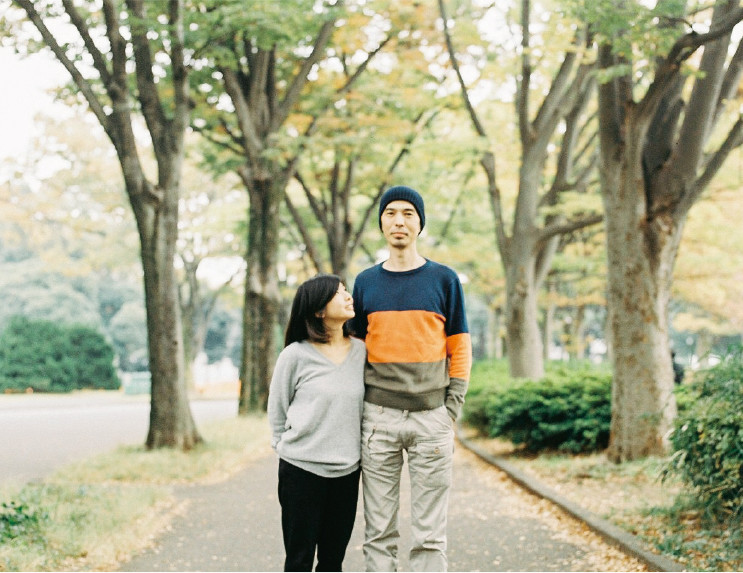
PROFILE
高澤敬介、瑞穂によるユニット。2005年から活動をスタート。トロフィーをはじめ、ロゼットなどの「称えるかたち」をリサーチしながら、国内外問わず取材を重ね、その意味や由来を咀嚼しながらオリジナルのアイテムを製作している。展示や販売、国内で数多くのワークショップを開催。国内外を問わず数多くのブランドとの共作も発表している。
A creative unit formed by Keisuke and Mizuho Takazawa in 2005. The duo researched various forms of &lsqou;praise’ through trophies and rosettes by visiting people around the globe to masticate the meaning and origins of such items in order to create their own original products. They display and sell their products and hold many rosette making workshops in Japan. Recently they have announced collaborations with many brands in and outside of Japan.